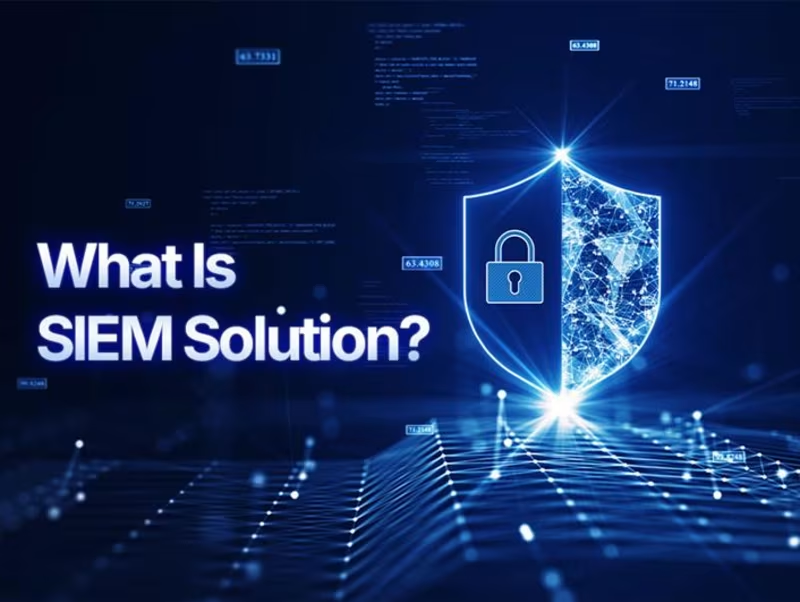Resource / Online Journal
What Is SIEM Solution? A Comprehensive Guide to Security Management
Learn what is SIEM solution, discover how to select the best SIEM solution for your organization. Learn key evaluation criteria, deployment models, and strategic benefits of SIEM tools to enhance threat detection, compliance, and security operations.
Published on Oct 29, 2025

SIEM is a security framework that aggregates, normalizes, and correlates event data from diverse sources, including networks, endpoints, applications, and cloud platforms. By applying advanced analytics and real-time monitoring, Security Information and Event Management (SIEM) enable organizations to identify anomalies, uncover malicious activity, and accelerate incident response.
Legacy tools often operate in isolation, creating blind spots that attackers exploit. SIEM eliminates these gaps by offering centralized visibility, context-driven alerts, and compliance-ready reporting. Whether you’re deploying SIEM for the first time or optimizing an existing platform, this guide will clarify why SIEM remains pivotal in defending against today’s dynamic threat landscape.
What Is SIEM Solution?
SIEM solutions operate by aggregating and normalizing security telemetry from multiple layers of an IT ecosystem, networks, endpoints, cloud workloads, applications, and security appliances. This standardized data enables correlation and advanced analytics, including rule-based detection, User and Entity Behavior Analytics (UEBA), and machine learning models. These capabilities allow SIEM platforms to spot anomalies, uncover attack indicators, and deliver real-time threat alerts. Beyond detection, SIEM supports historical event analysis and forensic investigations, giving security teams a complete view of incidents.
SIEM technology also supports continuous monitoring, incident response, and security operations, giving security analysts and security teams the ability to analyze security events, prioritize alerts, and respond to security incidents quickly. By integrating threat intelligence feeds and enabling security orchestration, SIEM systems provide comprehensive security monitoring and combined security information management for modern enterprises.
Early SIEM systems were primarily focused on log management and compliance reporting, often deployed on-premises with limited scalability. Today’s Next-Gen SIEM solutions leverage cloud computing, AI-driven analytics, and threat intelligence integration to address evolving cyber threats. Modern SIEM capabilities include automated incident response, security orchestration, and visual attack timelines, enabling faster triage and remediation, even for security operations centers (SOC) with limited resources.
These advancements allow SIEM tools to enhance threat detection capabilities, support threat hunting, and integrate with other security solutions for a unified defense strategy against internal and external threats.
SIEM systems are critical for threat detection and response, helping organizations uncover insider threats and external threats through data aggregation and analyzing log data. They also simplify compliance reporting for regulations like GDPR, HIPAA, and PCI DSS, while improving security management by providing risk scoring and prioritized alerts. By correlating event data across multiple systems, SIEM technology enables security operations centers to maintain continuous monitoring and safeguard sensitive data against cyber threats.
Benefits of Using a SIEM Solution
Modern SIEM solutions deliver continuous security monitoring across the entire IT environment, aggregating log and event data from network devices, cloud services, and security systems. By applying advanced analytics, machine learning, and Entity Behavior Analytics (UEBA), SIEM tools can detect threats that traditional security tools often miss.
Compliance with frameworks like PCI DSS, HIPAA, GDPR, and ISO 27001 requires accurate log data and security event management. SIEM systems automate data collection, aggregation, and secure storage of security information, generating audit-ready reports and dashboards for compliance reporting.
Alert fatigue caused by excessive security alerts and false positives is a major challenge for security analysts. SIEM technology leverages AI-driven analytics to correlate event data from multiple sources, filtering out benign anomalies and prioritizing genuine security incidents. This improves threat detection capabilities, enhances operational efficiency, and allows security operations centers (SOC) to focus on incident response and threat hunting.
SIEM acts as the backbone of security operations, providing centralized visibility and data correlation across multiple systems, including cloud environments and on-premises infrastructure. Integration with Security Orchestration, Automation, and Response (SOAR) enables automated workflows, incident triage, and coordinated remediation. These capabilities empower SOC teams to manage evolving cyber threats, streamline incident response, and maintain a robust security posture without relying solely on manual intervention.
How to Choose the Right SIEM Solution
1. Define Your Organizational Needs
Start by assessing your IT environment, business size, and industry-specific requirements:
- Threat detection goals: Are you focused on insider threats, external attacks, or compliance?
- Compliance mandates: Industries like finance, healthcare, and government require SIEMs that support HIPAA, PCI DSS, GDPR, and audit-ready reporting.
- Security operations maturity: Choose a SIEM that aligns with your SOC capabilities, from basic log management to advanced security orchestration and incident response.
2. Prioritize Scalability, Integration & Automation
Modern SIEMs go beyond log collection:
- Scalability: Cloud-native and hybrid SIEMs support distributed environments, IoT, and remote work.
- Integration: Ensure compatibility with EDR, SOAR, firewalls, and cloud services.
- Automation: Look for SOAR integration, playbook automation, and AI-driven alert triage to reduce manual effort.
3. Evaluate Pricing Models and Vendor Support
Cost and support are critical to long-term success:
- Pricing models: Understand whether the vendor charges by data volume, assets, users, or subscription tiers.
- Support quality: Assess vendor responsiveness, onboarding assistance, and SLA guarantees.
4. Compare Features Based on Use Cases
Use a checklist to evaluate:
- Log aggregation and normalization
- Real-time event correlation
- Threat intelligence feeds
- User and Entity Behavior Analytics (UEBA)
- Security automation and orchestration
- Historical search and forensic analysis
5. Choose the Right Deployment Model
- On-premises: Offers control but requires infrastructure.
- Cloud-native: Ideal for scalability and centralized monitoring.
- Hybrid: Balances flexibility and compliance needs.
Choosing the right security solution can feel overwhelming, and that's exactly where cybersecurity solution provider TechDemocracy steps in. Our Managed Security Operations Center (SOC) services are designed to simplify cybersecurity for you. We combine advanced SIEM technology with expert monitoring to help your organization detect threats early, respond quickly, and stay compliant.
Emerging Trends in Security Information and Event Management (SIEM)
The next generation of SIEM solutions is embracing AI-driven analytics and machine learning to deliver predictive security. These capabilities enable SIEM systems to analyze security data continuously, learn from historical patterns, and anticipate potential threats before they materialize.
Organizations are increasingly combining SIEM technology with XDR platforms to achieve a unified security posture. This integration extends SIEM’s capabilities beyond log management and event correlation, enabling security teams to leverage threat hunting, incident response automation, and security orchestration across endpoints, networks, and cloud environments. The result is a more holistic approach to security management, reducing blind spots and accelerating incident remediation.
Adoption of SIEM tools is expanding across sectors such as finance, healthcare, retail, and government, driven by stringent compliance mandates like PCI DSS, HIPAA, and GDPR. These industries rely on SIEM for continuous monitoring, audit-ready compliance reporting, and risk management to safeguard sensitive data against internal and external threats. Industry-specific SIEM deployments often integrate threat intelligence integration and predefined rules tailored to regulatory frameworks.
The transition from on-premises SIEM systems to cloud-native or hybrid architectures is accelerating. Modern SIEM platforms leverage cloud computing for scalability, centralized security information management, and real-time security monitoring across distributed environments. These deployments support multiple systems, IoT devices, and remote work scenarios, ensuring comprehensive security monitoring while reducing infrastructure overhead.
Conclusion
SIEM plays a vital role in modern security strategies by enabling centralized visibility, real-time threat detection, and compliance reporting. Adopting Next-Gen SIEM empowers organizations to proactively defend against evolving cyber threats. Now is the time to evaluate SIEM options that align with your business goals and security needs, and partner with experts like TechDemocracy to guide the way today!
Recommended articles


24/7 SOC Monitoring: Challenges and Solutions for Continuous Security
Take Your Identity Strategy
to the Next Level
Strengthen your organization's digital identity for a secure and worry-free tomorrow. Kickstart the journey with a complimentary consultation to explore personalized solutions.